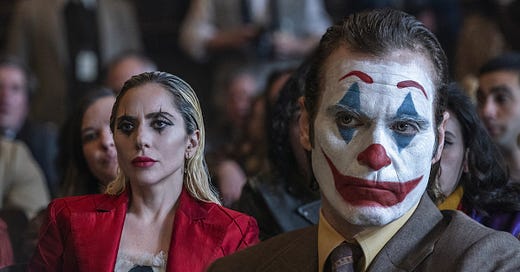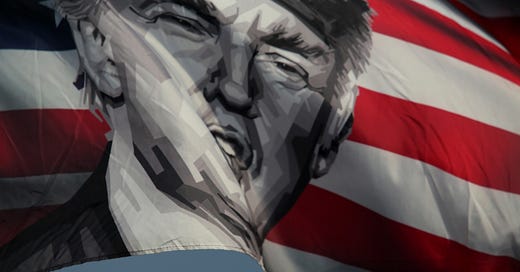
I think it’s impossible to recall the appeal of 2019’s Joker—an R-rated comic book movie without any superheroes that grossed more than a billion dollars worldwide—without remembering how weird everything felt toward the end of 2019. A simmering rage had been building for years and society writ large was finding release points: there were angry rallies for and against Donald Trump; the reckoning that was #MeToo burned through Hollywood; white supremacists were on the march on college campuses and across city streets; black-masked Antifa counterprotesters met them on the same streets and quads. It was a genuinely strange moment, one made all the stranger by the unsettled American political scene and the unsettled mind within its most famous address, 1600 Pennsylvania Avenue.
Joker came out that October—five years ago today, in fact, just a few months before things reached a rolling boil with the COVID restrictions and George Floyd protests of 2020. And while I understand some of the issues folks had with this movie—that it’s a Scorsese pastiche; that Phoenix’s character bears little resemblance to “the Joker”—one that I never quite grokked was the complaint that the film’s message was muddled. The message was pretty straightforward: People feel like society is broken and they’re angry and that anger is curdling into something quite ugly. That the mob wearing Joker masks at the end of the film could code as left-wing Antifa rioters or red-hat-wearing incels—or Hong Kong freedom fighters or anti-Hezbollah protesters in Lebanon—was a feature, not a bug. It felt like everyone was mad, and that everyone was going a little mad.
All of which is to say that even if you didn’t love Joker on a storytelling level, at the very least I think you have to acknowledge that it captured a sensibility. As such, it remains a vibrant reminder of an incredibly weird moment in the world mood. It has a reason for existing.
Joker: Folie à Deux does not have a reason for existing, and as such, it does not work. Like, at all. It does not work as a comic book movie despite references to Harvey Dent and other DC mainstays. It does not work as a courtroom drama, despite the fact the second half of the film takes place largely within a courtroom. It does not work as a romance movie or a romcom, despite the film’s nominal reason for being is the couple of Arthur Fleck, aka Joker, and Lee Quinzel (Lady Gaga). It does not work as a musical, despite the numerous musical interludes. It doesn’t even work as an actor’s showcase, despite having great talents like Phoenix, Brendan Gleeson, and Catherine Keener.
Joker: Folie à Deux is as badly misconceived a movie as I can remember seeing. The first half—which takes place largely in Arkham Asylum with the aforementioned musical interludes providing brief moments of “escape”—is almost criminally dull, just an endless slog of gray corridors and mumbling characters. It is, simply, dramatically inert, lacking in stakes, lacking in humor, lacking in action.
It is also visually inert: how do you make a nine-figure Joker movie with musical interludes and shoot them in the dullest way possible? I’m not expecting director Todd Phillips to be as virtuosic as, say, Steven Spielberg was in West Side Story; he simply doesn’t have that kind of camera work in him. But everything is so staid and locked down, the sets all look so chintzy. And Joaquin Phoenix—who again brings a sort of wiry physicality that calls to mind a strung-out indie rocker who moonlights as a tap dancer—simply cannot sing. Yes, he can still act, and the few moments in this movie that come close to working are when he’s allowed to get silly, as when he does a half-assed Foghorn Leghorn impersonation in the courtroom or when he nearly breaks down while being interviewed by Steve Coogan’s Paddy Meyers. (Coogan himself seems to be doing a half-assed Alan Partridge, but that’s neither here nor there.) It’s unfair to ask Phoenix to sing alongside Lady Gaga, who has real pipes. But then, it’s also unfair to ask her to perform alongside Phoenix, who is one of the best actors of his generation. The whole thing is almost comically mismatched.
Honestly, the film feels like a $200 million prank by Phillips, as if Warner Bros. backed a dump truck full of money up to his house and gave him carte blanche and he decided to create the most boringly abrasive film he could imagine. (While this sounds like a contradiction, I assure you it isn’t; fans of the first film are going to actively hate the film’s final ten minutes, if I had to guess.)
Directors are often given credit for “subverting expectations,” for not giving the fans of franchises what they desire, and this is the only level on which Joker: Folie à Deux is not an abject failure: I can’t imagine anyone who appreciated the first film finding much to love in this one. Credit where it’s due, I suppose.
One of the reasons I have such a soft spot for Megalopolis is that it’s the opposite of Joker: Folie à Deux. It is neither cynical pandering nor coated in IP silliness; it may be a mess, but it’s an earnest mess. Sadly, I had to defend it and Francis Ford Coppola’s honor from my cohosts on Across the Movie Aisle this week. Something tells me they’ll be begging for a return to New Rome by the time they get done watching Folie à Deux. If you want to catch the bonus episode that went live this morning, make sure to sign up for Bulwark+!
Links!
Congrats to Jason Pargin, whose new book I’m Starting to Worry About This Black Box of Doom came in at number 19 on USA Today’s bestseller list. The lesson, as always: Make sure to show up on The Bulwark Goes to Hollywood if you want to move product!
Speaking of the pod, this week I’m talking to Brandon Katz of Parrot Analytics, and if you want to prep for that episode, make sure to read his Observer column on audience acquisition and streaming churn. We’re gonna get wonky, folks!
One of my favorite regular features is Will Harris’s Random Roles column over at the AV Club, the best of which involve him interviewing character actors about their careers. His chat with Troy Evans is just delightful and filled with really entertaining anecdotes about working with, among others, John Hughes, Sly Stallone, Dolly Parton, and Michael Jackson.
Kids today can’t read books. Seems bad!
Assigned Viewing: Logan Lucky (Netflix)
I rewatched this because a few people mentioned Adam Driver’s performance in it after reading my Megalopolis review. And he’s good! But so are Riley Keough and Daniel Craig and Katie Holmes and David Denman and Jack Quaid and David Denman and Seth MacFarlane and Macon Blair and Hilary Swank. Plus, Steven Soderbergh understands the most important thing about a heist movie: Audiences don’t care how you get the money, they care how you get away with the money. They assume you’ll get the money! It’s the getaway that’s interesting!


















"That the mob wearing Joker masks at the end of the film could code as left-wing Antifa rioters or red-hat-wearing incels—or Hong Kong freedom fighters or anti-Hezbollah protesters in Lebanon—was a feature, not a bug. It felt like everyone was mad, and that everyone was going a little mad."
See "V for Vendetta"...
While I found it extremely depressing, I think the focus on if it was "good" or not needs to come from what the film showed us, not what it didn't. The mismatch between Gaga & Phonenix, the darkness/ grey, and the fractured scenes that do not end in a climax, seem to indicate this is how Arthur's brain was experiencing life.
As a fractured person, his fantasies never complete themselves, everything is grandiose (ex: having an incredibly talented singer in his corner singing just to him), because that is how he experiences life from inside his head.
This is much more about how the Joker experiences the world than how the world experiences the Joker.
I see it as a two hour peek into a psyche that fooled itself into thinking "the Joker" will somehow get away with it all and leave Arthur behind.